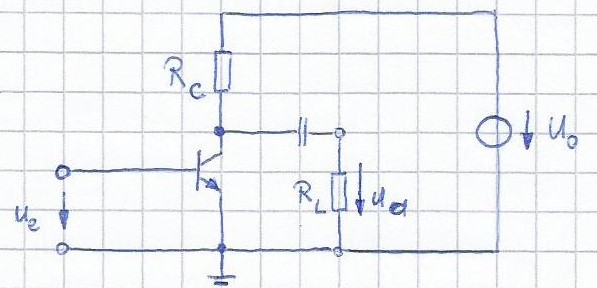1. Question
What is the maximum output over \$R_L\$ and the maximum efficiency \$\eta\$ for the amplifier circuit shown below:

Below you will find my solution. Is this done correctly? What would you have done differently?
2. Voltage over \$R_L\$
Assumed is an ideal transistor with infinite current amplification \$\beta\$ and saturation voltage \$U_{ CE_{ sat } }\$ to be 0. Therefor the base current is 0 and the voltage drop over the transistor is considered constant for the whole output range. Furthermore is the output voltage \$u_a\$ sinusoidal.
This means for $$u_a(t)=\hat{U}_a\sin(\omega t)$$ the amplitude \$\hat{U}_a\$ is the voltage divider over \$R_L\$, when the maximum of the dynamic range of the transistor is reached, that no current flows over the transistor.
$$U_{a,\,max}=U_0\frac{R_L}{R_L+R_C}$$ $$\hat{U}_{a,\,max}=\frac{U_{a,\,max}}{2}$$ $$U_{a,\,eff,\,max}=\frac{\hat{U}_{a,\,max}}{\sqrt{2}}$$
The root mean square leads to:
$$U_{a,\,eff,\,max}=\frac{U_0}{2\sqrt{2}}\frac{R_L}{R_L+R_C}$$
3. Maximum output \$P_L\$ over \$R_L\$
$$P_L=\frac{1}{2}\frac{U_{a,\,eff,\,max}^2}{R_L}$$ $$P_L=\frac{U_0^2}{16}\frac{R_L}{(R_L+R_C)^2}$$
For \$\frac{dP_L}{dR_L}=0\$ leads \$R_L=R_C\$ to the maximum output over \$R_L\$.
$$P_{L,\,max}=\frac{1}{64}\frac{U_0^2}{R_L}$$
4. Maximum efficiency \$\eta\$
The total circuit power is the voltage over both resistors which is \$U_0\$:
$$P_{in}=\frac{1}{2}\frac{U_0^2}{R_L+R_C}$$
With the given condition that \$R_L=R_C\$: $$P_{in}=\frac{1}{4}\frac{U_0^2}{R_L}$$
The maximum efficiency \$\eta\$ is: $$\eta=\frac{P_L}{P_{in}}=\frac{1}{16}=6.25\%$$

